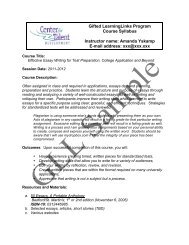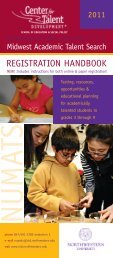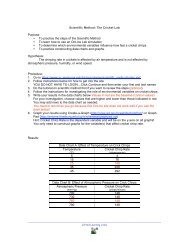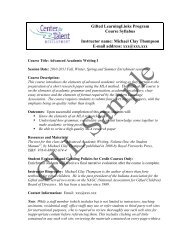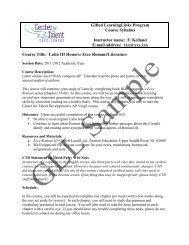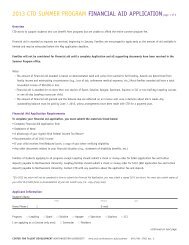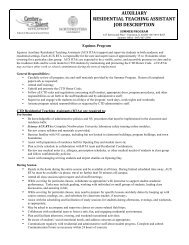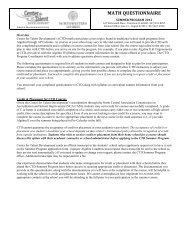2012 Summer Program - Center for Talent Development ...
2012 Summer Program - Center for Talent Development ...
2012 Summer Program - Center for Talent Development ...
- No tags were found...
You also want an ePaper? Increase the reach of your titles
YUMPU automatically turns print PDFs into web optimized ePapers that Google loves.
Week 2 (July 16 – 20)ARCHITECTURE & ENGINEERINGWhat principles of physics, architectureand engineering are behind some of theworld’s greatest structures? In thesecourses, activities focus on learning aboutthe origins and construction of existingstructures built all around the globe.Through hands-on investigation andinquiry, students are provided with anexcellent foundation <strong>for</strong> future scientificinvestigations in physics and engineering.2-C (PreK/K) Building BridgesTruss, arch, suspension, and more —young engineers learn about bridge structuresand study famous examples fromaround the world. Students create theirown bridge models based on the principlesof physics and through the process ofscientific inquiry.2-C (K/1) Digging Canals & TunnelsFrom the canals of Italy, Egypt andPanama to tunnels <strong>for</strong> cars, water, andpower lines, aspiring engineers considerthe development of these critical transportationsystems. Students design andconstruct models and explain their planningprocess to peers and instructors.2-C (1/2) Designing Sailing ShipsFollowing in the footsteps of naval architects,novice designers examine the differentmethods of assembling ships completewith keels, hulls, and masts. Studentsimplement and test their designs, evaluatingthe strengths and weaknesses of theirships.2-C (2/3) Raising Skyscrapers & TowersHow do you build a 200-story building soit won’t topple? How does wind influencean architect’s design? Student architectsmust answer these questions and more asthey uncover the engineering and physicsbehind tall towers and stupendous skyscrapers.Leapfrog promotes “hands-in” learning.Week 3 (July 23 – 27)DANGER ZONE! SAVING THE PLANETEarth supports a mind-boggling range ofliving things from amoebas to humans.Scientists and engineers are still learningabout protecting the Earth’s environmentsand finding innovative ways to conserve itsresources. Students engage in inquirybasedexperiments that explore the varietyof ecosystems on our planet and introducestudents to topics in ecology, geology,oceanography, and limnology.3-C (PreK/K) Wildfire!Forests and prairies are filled with amazingplants and animals creating a very diverseecosystem. Wildfires, a threat to theseenvironments, are dangerous to people,plants, animals and their habitats. Studentsconduct hands-on experiments and observationsthat demonstrate how ecosystemsare impacted by a major event like a wildfire.Students also explore ways people canhelp prevent wildfires and preserve delicateecosystems.3-C (K/1) Honeybees in Danger!Bees do more than buzz and sting! Theyare very important to production of ourfood. Recently, scientists discovered thathoneybees have been gradually disappearingfrom our environment. Studentsresearch the causes of the dwindling beepopulation and study the impact on farmingand other important ecosystems.Building models and dioramas, conductingpollination experiments and tastingreal honey are just some of the courseactivities.3-C (1/2) Oil Spill!What happens to plants, animals, peopleand our waterways after an oil spill?Students in this course learn about waterwaysand aquatic ecosystems and researchthe impact of pollution, such as oil, onrivers, lakes and oceans. Through visualdemonstrations and experiments, studentslearn about water quality and use problemsolving to discover ways to keep our waterclean.3-C (2/3) Plastic Pileup!People throw away plastic bottles, cups,wrappers and toys every day. What happensto all that plastic after it becomesgarbage? Why do we have to worry moreabout plastic than a banana peel? Throughobservations and experiments aspiring scientistsexplore this topic and learn aboutthe concept of “zero waste.” The scienceof decomposition and composting isexplored through hands-on (aka “smellyand stinky”) experiments that demonstratewhat it means to be biodegradable.847/491-3782 www.ctd.northwestern.edu NORTHWESTERN UNIVERSITY CENTER FOR TALENT DEVELOPMENT 13





